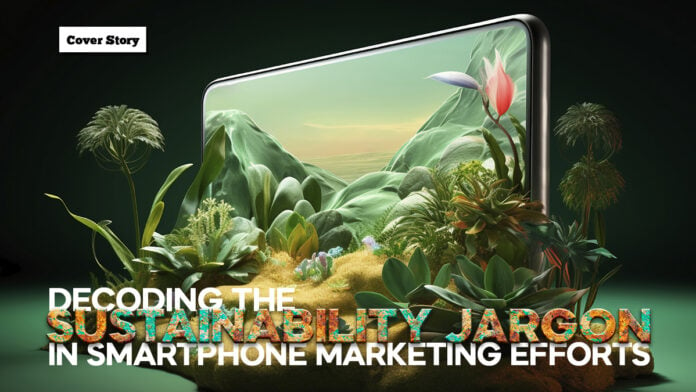In today’s world where environmental consciousness and care are more important than ever, smartphone marketing efforts — from ads to packaging — have slowly but surely been integrating more and more buzzwords related to climate change and sustainability. After all, the information and communication technology (ICT) industry’s environmental footprint cannot be ignored.
According to a 2023 press release from the International Telecommunication Union (ITU), the United Nations’ arm for ICT-related matters, the sector is estimated to be responsible for between 1.5 to 4% of global greenhouse gas (GHG) emissions. From the extraction of minerals from the Earth, the energy-intensive manufacturing processes for components, and even the logistics of shipping units from the factory to your doorstep: all these taken together equate to significant environmental impact. Not to mention the amount of e-waste produced yearly, which according to the United Nations Environment Programme (UNEP) amounts to around 54-million metric tonnes annually.
How can we then discern whether the eco-friendly claims in smartphone marketing efforts are legit or just greenwashing? Arguably, this starts with knowing what the jargon actually means and how these apply in the context of smartphone production and usage. Let’s delve into some of the terminology and uncover how these concepts are applied in the tech industry’s pursuit of a greener tomorrow.
Net zero, carbon neutral, and absolute zero, and carbon neutral
While all refer to a state where there is virtually no more emissions — such as carbon dioxide, methane, or sulphur dioxide — attributable to activities, there are distinct differences. Net zero specifically refers to when companies reduce a major amount of its emissions within its value chain, with any remaining amount neutralized or balanced with equivalent GHG removal measures within a specified time period. Emissions can be reduced through means such as improving carbon sinks (such as forests, which remove carbon dioxide via photosynthesis) or capturing, storing, and then converting GHGs into fuel or energy. Hence the term “net”.
‘Carbon-neutral’ does not specifically pertain to avoiding emissions through GHG-free value chains. Rather, first, it is a term that only refers to carbon emissions. Second, companies aiming to be carbon neutral can still technically emit as much carbon as they want as long as they are able to offset the same amount of carbon inside or outside their value chain. Meanwhile, absolute zero refers to the complete absence of GHG emissions from human activities.
Absolute zero is nigh impossible to achieve. As such, net zero and carbon neutrality is the more common goal for most companies inside and outside the tech industry. For smartphones, brands often aim to reduce emissions throughout the entire product lifecycle, from manufacturing to disposal. One of the ways they do this is by using renewable energy sources and using energy-efficient practices in their manufacturing facilities, recycled materials in product components, or producing more energy-efficient smartphones. For carbon offsetting, brands can also choose to invest in renewable energy projects that are not tied to their grid, embark on reforestation activities, or capture carbon dioxide from the air directly, among others.

Sustainable packaging
In addition to making the smartphone-making process as eco-friendly as possible, manufacturers have also started to package them in sustainable materials to further minimize their environmental impact and waste. These solutions include utilizing recycled, recyclable, or biodegradable materials, minimalistic box designs, using biodegradable soy ink for prints (which are more eco-friendly to produce and use), and removing plastic wrappings. The World Economic Forum in 2020 reported that over 400 million tonnes of plastic waste is produced yearly, and around 50% of that is from packaging. Using more sustainable packaging means less GHG emissions but also lessens tech-related waste leaking into the environment.
Managing e-wastes
According to a 2021 Deloitte article, most of a smartphone’s GHG emissions come from its creation. Meanwhile, Morgan Stanley reported that in 2020, the average lifespan of smartphones worldwide before they are replaced was just over 33 months. Therefore, ensuring that units are able to last for years at a time greatly contributes to lessening its environmental footprint per year. This could be achieved by making smartphones physically more durable, lessening the need to replace consumable parts or prematurely replacing the unit altogether, offering better and longer operating system support to ensure that it does not feel outdated even after years of use, and even establishing “certified refurbished programs” to give devices a new lease on life either in another market segment or another country.
Understanding sustainability jargon such as the ones above is important for us consumers to better discern what a company is saying versus what it is actually doing in the fight against climate change. With the industry’s significant environmental footprint and the mounting challenges of e-waste, informed consumers can drive demand for truly sustainable practices, from production to packaging to end-of-life management. This awareness is an important first step towards shaping a greener future for all.
Words by Chris Noel Hidalgo
Also published in GADGETS MAGAZINE March 2024 Issue
